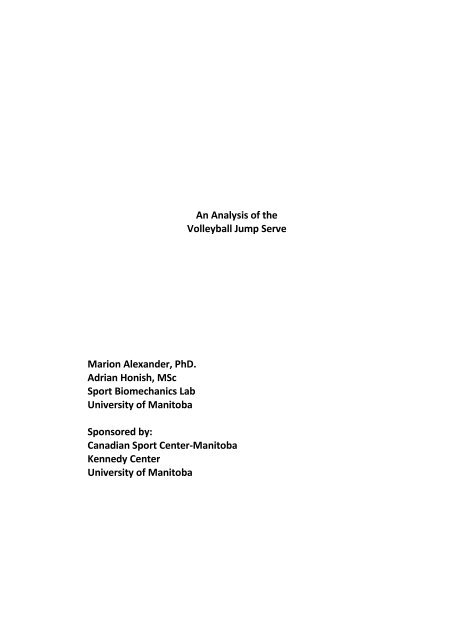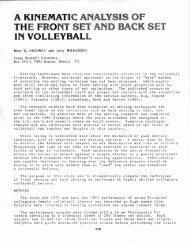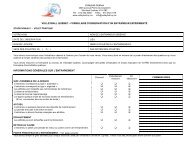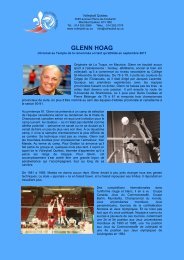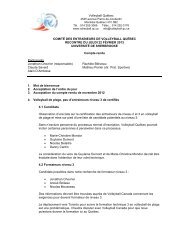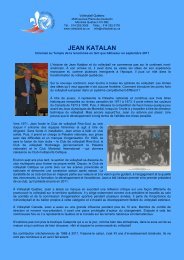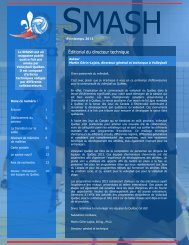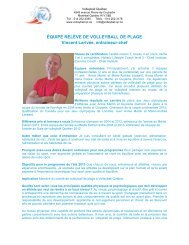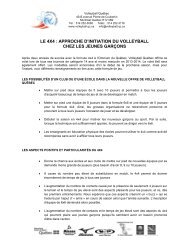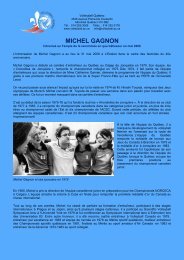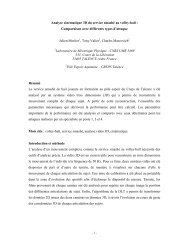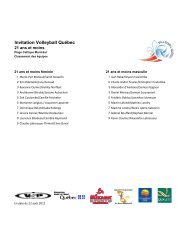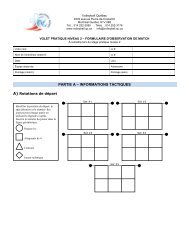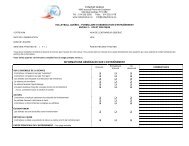An Analysis of the volleyball serve
An Analysis of the volleyball serve
An Analysis of the volleyball serve
You also want an ePaper? Increase the reach of your titles
YUMPU automatically turns print PDFs into web optimized ePapers that Google loves.
<strong>An</strong> <strong>An</strong>alysis <strong>of</strong> <strong>the</strong><br />
Volleyball Jump Serve<br />
Marion Alexander, PhD.<br />
Adrian Honish, MSc<br />
Sport Biomechanics Lab<br />
University <strong>of</strong> Manitoba<br />
Sponsored by:<br />
Canadian Sport Center-Manitoba<br />
Kennedy Center<br />
University <strong>of</strong> Manitoba
The Volleyball Jump Serve<br />
One <strong>of</strong> <strong>the</strong> most dramatic skills in modern <strong>volleyball</strong> is <strong>the</strong> spike <strong>serve</strong>, or <strong>the</strong><br />
jump <strong>serve</strong>, which provides an exciting and dynamic skill, that is captivating for<br />
players and spectators alike.<br />
Introduction<br />
The player starts about five meters behind <strong>the</strong> end line <strong>of</strong> <strong>the</strong> court, uses a fast<br />
and explosive run up, a dynamic spike take<strong>of</strong>f and an exciting spike action at<br />
<strong>the</strong> peak <strong>of</strong> <strong>the</strong>ir jump that sends <strong>the</strong> ball across <strong>the</strong> net at speeds <strong>of</strong> over 27<br />
m/s with heavy topspin and at a sharp downward angle. The spike <strong>serve</strong> has<br />
become a dangerous <strong>of</strong>fensive weapon for <strong>the</strong> top <strong>volleyball</strong> teams <strong>of</strong> today,<br />
as a great spike <strong>serve</strong>r can produce a number <strong>of</strong> aces over <strong>the</strong> course <strong>of</strong> a<br />
match. The spike <strong>serve</strong> is somewhat similar to <strong>the</strong> spike at <strong>the</strong> net, except <strong>the</strong><br />
velocities after impact are somewhat lower for <strong>the</strong> <strong>serve</strong> when compared to<br />
<strong>the</strong> spike (Tant, Greene et al. 1993). A study <strong>of</strong> <strong>the</strong> spike vs. <strong>the</strong> <strong>serve</strong> for<br />
collegiate <strong>volleyball</strong> players revealed similar speeds for <strong>the</strong> male athletes but<br />
slower speeds for <strong>the</strong> female <strong>serve</strong> when compared to <strong>the</strong> spike (male jump<br />
<strong>serve</strong> 19.7 m/s, male spike 22.4 m/s, female jump <strong>serve</strong> 13.2 m/s, female spike<br />
17.8 m/s). A study <strong>of</strong> <strong>the</strong> front row spikes <strong>of</strong> elite international <strong>volleyball</strong><br />
spikers reported mean impact ball speeds <strong>of</strong> 27 m/s (Coleman 1993).<br />
It is generally agreed that <strong>the</strong> top jump <strong>serve</strong>rs <strong>of</strong> modern <strong>volleyball</strong> are <strong>the</strong><br />
players who play for Cuba, <strong>the</strong> top men’s team in <strong>the</strong> world over <strong>the</strong> past<br />
decade. These players are generally very tall, <strong>of</strong>ten up to 210 cm and have<br />
very high vertical jumps that allow <strong>the</strong>m to produce a downward angle on <strong>the</strong><br />
ball: a fact exacerbated by <strong>the</strong> heavy topspin usually applied. Their strength<br />
and athleticism also allow <strong>the</strong>m to produce very high hand velocities at impact<br />
that produce high ball velocities that are very difficult for <strong>the</strong> opposition to<br />
return. There are few detailed descriptions <strong>of</strong> <strong>the</strong> techniques <strong>of</strong> <strong>the</strong> spike<br />
<strong>serve</strong> in elite <strong>volleyball</strong> players, so little is known regarding <strong>the</strong> optimal joint<br />
angles and body positions to maximize ball speed. <strong>An</strong> examination <strong>of</strong> <strong>the</strong><br />
<strong>serve</strong>s <strong>of</strong> <strong>the</strong> top players in <strong>the</strong> world may provide some useful information<br />
regarding optimal technique, so that o<strong>the</strong>r skilled players will be able to<br />
emulate this skill and improve <strong>the</strong>ir own ball speed and accuracy. This analysis<br />
was conducted on <strong>the</strong> players <strong>of</strong> <strong>the</strong> 2005 NORCECA Championships, which<br />
included <strong>the</strong> National teams <strong>of</strong> Cuba, United States, Canada, Puerto Rico,<br />
Dominican Republic and Mexico. Over 300 jump <strong>serve</strong>s were filmed during<br />
<strong>the</strong> course <strong>of</strong> <strong>the</strong> championships, held in Winnipeg in September 2005. The<br />
top <strong>serve</strong>rs were analyzed and compared to <strong>the</strong> less skilled <strong>serve</strong>rs<br />
participating in <strong>the</strong> championships, resulting in <strong>the</strong> following analysis.
The spike <strong>serve</strong> has many similarities to <strong>the</strong> spike itself. The player strikes <strong>the</strong><br />
ball with maximum force at <strong>the</strong> peak <strong>of</strong> his jump, and tries to place it so that<br />
<strong>the</strong> opposing player cannot receive it cleanly. It has been suggested that a<br />
successful spike is determined by three factors, which are likely similar to<br />
those <strong>of</strong> <strong>the</strong> jump <strong>serve</strong>:<br />
• The position <strong>of</strong> <strong>the</strong> ball at impact<br />
• The speed <strong>of</strong> <strong>the</strong> ball after impact<br />
• The direction <strong>of</strong> movement <strong>of</strong> <strong>the</strong> ball after impact (Chung, Choi et<br />
al. 1990)<br />
In <strong>the</strong> jump <strong>serve</strong> <strong>the</strong> ball position at impact is determined by <strong>the</strong> toss <strong>of</strong> <strong>the</strong><br />
<strong>serve</strong>r - an effective <strong>serve</strong> requires a perfectly placed toss and a perfectly<br />
timed run up. The higher <strong>the</strong> point <strong>of</strong> impact, <strong>the</strong> sharper <strong>the</strong> downward<br />
angle <strong>of</strong> <strong>the</strong> <strong>serve</strong>, and <strong>the</strong> more margins for error <strong>the</strong>re is for <strong>the</strong> <strong>serve</strong>r to<br />
utilize a higher ball velocity. This makes it faster to arrive on <strong>the</strong> o<strong>the</strong>r side <strong>of</strong><br />
<strong>the</strong> net and thus <strong>the</strong>re is less time for <strong>the</strong> receiver to interpret <strong>the</strong> path <strong>of</strong> <strong>the</strong><br />
ball and move into position to play it, increasing <strong>the</strong> chance <strong>of</strong> an error or an<br />
inaccurate pass.<br />
Figure 1. Sequence photos <strong>of</strong> <strong>the</strong> spike <strong>serve</strong> by top international player.<br />
Ready Position and Ball Toss<br />
The following description describes <strong>the</strong> jump <strong>serve</strong> for a right handed <strong>serve</strong>r -<br />
foot and hand positions would be on <strong>the</strong> opposite side for a left handed<br />
player. In <strong>the</strong> ready position for <strong>the</strong> spike <strong>serve</strong>, <strong>the</strong> <strong>serve</strong>r stands about 5 m
ehind <strong>the</strong> end line and holds <strong>the</strong> ball in <strong>the</strong> serving hand. The feet are side by<br />
side or <strong>the</strong> left foot is slightly behind <strong>the</strong> right and <strong>the</strong>y are pointing toward<br />
<strong>the</strong> net. As <strong>the</strong> step is taken onto <strong>the</strong> right foot, <strong>the</strong> right arm supporting <strong>the</strong><br />
ball is raised in front <strong>of</strong> <strong>the</strong> body for <strong>the</strong> toss by a combination <strong>of</strong> shoulder<br />
flexion and elbow flexion. <strong>An</strong> alternative method <strong>of</strong> footwork for <strong>the</strong> toss is to<br />
release <strong>the</strong> ball as <strong>the</strong> right foot is leaving <strong>the</strong> ground for <strong>the</strong> toss and <strong>the</strong> left<br />
foot is being planted. Volleyball jump <strong>serve</strong>rs most <strong>of</strong>ten use <strong>the</strong> hitting arm<br />
as <strong>the</strong> arm used to toss <strong>the</strong> ball for <strong>the</strong> <strong>serve</strong>, so a right handed <strong>serve</strong>r will use<br />
<strong>the</strong> right hand to toss <strong>the</strong> ball. A study <strong>of</strong> <strong>the</strong> toss using ei<strong>the</strong>r hand concluded<br />
that tossing with <strong>the</strong> serving hand utilized increased range <strong>of</strong> motion <strong>of</strong> <strong>the</strong><br />
hitting arm and <strong>the</strong> trunk in <strong>the</strong> toss (Tant and Witte 1991). These actions<br />
produce a longer lever arm and greater mass to create optimum velocity in<br />
<strong>the</strong> hand. There may also be benefits in terms <strong>of</strong> coordination and rhythm by<br />
using <strong>the</strong> hitting arm to toss <strong>the</strong> ball.<br />
The ball is carried to a position in front <strong>of</strong> or just above <strong>the</strong> right shoulder and<br />
is <strong>the</strong>n released in a forward and upward pathway. The ball travels to a<br />
significant height <strong>of</strong> up to 10 m, <strong>the</strong>n drops to <strong>the</strong> position <strong>of</strong> contact about 2<br />
m inside <strong>the</strong> court. <strong>An</strong> accurate toss is an important aspect <strong>of</strong> <strong>the</strong> skilled spike<br />
<strong>serve</strong>, and takes many years <strong>of</strong> practice to perfect <strong>the</strong> exact timing, direction<br />
and height required for a reliable <strong>serve</strong>.<br />
Figure 2. Ball toss occurs <strong>of</strong>f <strong>the</strong> right foot, ball is tossed with<br />
<strong>the</strong> right arm, elbow extended, body leans for
Figure 3. Ball toss can also occur from <strong>the</strong> left foot, but this technique leaves only <strong>the</strong> final two<br />
steps <strong>of</strong> <strong>the</strong> run-up to build up horizontal velocity so is not recommended.<br />
Figure 4. Ball being released for <strong>the</strong> <strong>serve</strong> from <strong>the</strong> left foot, note high point <strong>of</strong> release above <strong>the</strong><br />
<strong>serve</strong>r’s head, since longer ball contact gives better control over <strong>the</strong> toss.<br />
The key to a reliable toss is <strong>the</strong> upward arm swing in which <strong>the</strong> ball must<br />
remain on <strong>the</strong> palm <strong>of</strong> <strong>the</strong> hand and <strong>the</strong> lower arm must remain in supination<br />
to support <strong>the</strong> ball squarely. The arm swing upwards is produced primarily by<br />
shoulder flexion and some elbow flexion during release <strong>of</strong> <strong>the</strong> ball, as well as<br />
some trunk extension. The elbow should remain close to extension to improve<br />
accuracy in <strong>the</strong> path <strong>of</strong> <strong>the</strong> ball to release. The ball should roll <strong>of</strong>f <strong>the</strong> finger<br />
tips rotating forward with topspin, to stabilize <strong>the</strong> ball’s flight and possibly help<br />
<strong>the</strong> generation <strong>of</strong> topspin at impact. The ball should be released as high as<br />
possible for greater accuracy, preferably above <strong>the</strong> head with full shoulder<br />
flexion (Figure 4).<br />
The ball is usually released during <strong>the</strong> forward shifting <strong>of</strong> <strong>the</strong> body weight over<br />
<strong>the</strong> right foot (Figure 2). However, some elite <strong>serve</strong>rs are seen to release <strong>the</strong><br />
ball as <strong>the</strong> weight is taken on <strong>the</strong> left foot (Figure 3). This technique is less<br />
desirable because <strong>the</strong> <strong>serve</strong>r <strong>the</strong>n only has <strong>the</strong> final two steps in which to build<br />
up <strong>the</strong> horizontal velocity for <strong>the</strong> <strong>serve</strong>. The body has little horizontal velocity<br />
as <strong>the</strong> ball is tossed for <strong>the</strong> <strong>serve</strong>, but following release <strong>the</strong> body starts to move<br />
forward toward <strong>the</strong> court with increasing speed. The speed <strong>of</strong> this first step, as<br />
well as <strong>the</strong> speed <strong>of</strong> <strong>the</strong> run up is determined by <strong>the</strong> skill <strong>of</strong> <strong>the</strong> <strong>serve</strong>r - <strong>the</strong><br />
more skilled <strong>the</strong> athlete <strong>the</strong> faster he can move into <strong>the</strong> hit. When <strong>the</strong> ball is<br />
released for <strong>the</strong> toss, it is no longer affected by <strong>the</strong> movements <strong>of</strong> <strong>the</strong> <strong>serve</strong>r<br />
but it will continue its parabolic path toward <strong>the</strong> court until it is struck by <strong>the</strong><br />
<strong>serve</strong>r in mid-air on <strong>the</strong> <strong>serve</strong>.
Run up<br />
The run up consists <strong>of</strong> 4 steps into <strong>the</strong> take<strong>of</strong>f, during which <strong>the</strong> <strong>serve</strong>r builds<br />
up forward momentum that he will use to load <strong>the</strong> legs for <strong>the</strong> jump. Loading<br />
<strong>the</strong> legs is <strong>the</strong> mechanism by which <strong>the</strong> run up velocity is slowed by an<br />
eccentric contraction <strong>of</strong> <strong>the</strong> hip, knee and ankle extensors, and this lowering <strong>of</strong><br />
<strong>the</strong> body weight will increase <strong>the</strong> flexion <strong>of</strong> <strong>the</strong> hips and knees and stretch <strong>the</strong><br />
muscles prior to <strong>the</strong> contraction for <strong>the</strong> jump. It has been reported that a<br />
longer run up is related to a higher jump in spiking with skilled <strong>volleyball</strong><br />
players, so those <strong>serve</strong>rs using a 4 step approach to <strong>the</strong> <strong>serve</strong> have <strong>the</strong><br />
potential to jump higher (Khayambashi 1977; Maxwell, Bratton et al. 1980).<br />
The velocity <strong>of</strong> <strong>the</strong> body’s center <strong>of</strong> gravity forward into <strong>the</strong> <strong>serve</strong> will be added<br />
to <strong>the</strong> velocity imparted to <strong>the</strong> ball from <strong>the</strong> arm and trunk movements. The<br />
faster <strong>the</strong> run up, <strong>the</strong> faster <strong>the</strong> horizontal velocity <strong>of</strong> <strong>the</strong> CG at impact and <strong>the</strong><br />
faster <strong>the</strong> ball will leave <strong>the</strong> hand (Figure 5). Horizontal CG velocities <strong>of</strong> 2.85 m/s<br />
have been reported for <strong>the</strong> jump <strong>serve</strong> <strong>of</strong> male collegiate <strong>volleyball</strong> players (Tant<br />
and Witte 1991).<br />
Figure 5. Long step onto <strong>the</strong> left foot to start <strong>the</strong> run up. A longer step is related to a faster run up,<br />
a faster run up is related to a higher jump and a faster <strong>serve</strong><br />
The weight is maintained over <strong>the</strong> right foot during <strong>the</strong> toss, and it is followed<br />
by a longer step onto <strong>the</strong> left foot following release. The step onto <strong>the</strong> left foot<br />
is critical in attaining a high horizontal speed at take<strong>of</strong>f and should be a long<br />
and explosive step. The step from <strong>the</strong> left foot back onto <strong>the</strong> right foot is <strong>the</strong><br />
longest step <strong>of</strong> <strong>the</strong> run up, and <strong>of</strong>ten covers a distance <strong>of</strong> up to 80% <strong>of</strong> <strong>the</strong>
<strong>serve</strong>r’s standing height. This long step onto <strong>the</strong> right foot is known as <strong>the</strong><br />
plant step, and <strong>the</strong> purpose <strong>of</strong> this step is to provide <strong>the</strong> braking forces for <strong>the</strong><br />
run up and allow <strong>the</strong> athlete to ga<strong>the</strong>r and prepare for take<strong>of</strong>f. The longer this<br />
step, <strong>the</strong> more skilled <strong>the</strong> <strong>serve</strong>r and <strong>the</strong> greater time and distance <strong>the</strong> <strong>serve</strong>r<br />
has to decelerate his forward velocity and prepare to take<strong>of</strong>f upwards<br />
(Alexander and Seaborn 1980). The right foot lands on <strong>the</strong> heel first, and <strong>the</strong>n<br />
<strong>the</strong> weight is taken over <strong>the</strong> whole foot as <strong>the</strong> knee and hip are flexed. The<br />
right foot plant is followed by deep flexion on this support leg, in preparation<br />
for <strong>the</strong> jump to follow. During this step <strong>the</strong> left foot is brought through to a<br />
position in front <strong>of</strong> <strong>the</strong> planted right foot, <strong>of</strong>ten up to 50 cm in front <strong>of</strong> <strong>the</strong><br />
right foot. As <strong>the</strong> left foot is planted, it is rotated toward <strong>the</strong> midline using hip<br />
medial rotation so that <strong>the</strong> toe is pointing to <strong>the</strong> sideline, or <strong>the</strong> foot is almost<br />
parallel to <strong>the</strong> end line <strong>of</strong> <strong>the</strong> court. This position allows <strong>the</strong> left foot and leg to<br />
act as an effective brake for <strong>the</strong> forward momentum <strong>of</strong> <strong>the</strong> run up, as well it<br />
positions <strong>the</strong> trunk at an angle to <strong>the</strong> net to prepare for trunk rotation into <strong>the</strong><br />
<strong>serve</strong>. It has been reported that <strong>the</strong> right leg is <strong>the</strong> dominant leg for most<br />
right-handed spikers, and provides a greater amount <strong>of</strong> <strong>the</strong> total force for <strong>the</strong><br />
take<strong>of</strong>f in <strong>the</strong> spike jump (Wielki and Dangre 1985). This is also <strong>the</strong> case for<br />
jump serving.<br />
As <strong>the</strong> athlete steps onto <strong>the</strong> right foot, <strong>the</strong> arms are left behind <strong>the</strong> body in<br />
extreme shoulder hyperextension- <strong>the</strong> arms should be horizontal or even past<br />
<strong>the</strong> horizontal to attain <strong>the</strong> maximum position for <strong>the</strong> arm swing forward (<br />
Figure 6). The athlete in <strong>the</strong> attached photo has <strong>the</strong> arms hyper extended to<br />
an angle <strong>of</strong> 30º above <strong>the</strong> horizontal (Figure 6). First contact with <strong>the</strong> heel <strong>of</strong><br />
<strong>the</strong> right foot should correspond with <strong>the</strong> position <strong>of</strong> maximum shoulder hyper<br />
extension. Maximum shoulder hyperextension is accompanied by trunk flexion<br />
that increases <strong>the</strong> range <strong>of</strong> shoulder extension. The optimal range <strong>of</strong> trunk<br />
flexion during <strong>the</strong> arm swing is in <strong>the</strong> range <strong>of</strong> 20º from <strong>the</strong> vertical. Decreased<br />
ranges <strong>of</strong> motion in <strong>the</strong> trunk flexion or shoulder hyperextension may lead to<br />
timing problems with <strong>the</strong> arm swing during take<strong>of</strong>f. The arm swing may <strong>the</strong>n<br />
be completed too soon in <strong>the</strong> jump take<strong>of</strong>f, and provides little force to increase<br />
ground reaction forces during take<strong>of</strong>f.
Figure 6. Plant step onto <strong>the</strong> right leg, heel strikes first and shoulders in maximum hyperextension<br />
above <strong>the</strong> horizontal, trunk leaning forward<br />
From this hyperextended position, <strong>the</strong> arms are swung forward, downward<br />
and upward in front <strong>of</strong> <strong>the</strong> body in order to provide increased vertical ground<br />
reaction forces for <strong>the</strong> jump. As well, <strong>the</strong> trunk moves from flexion to<br />
extension, and this forceful trunk extension will also increase <strong>the</strong> ground<br />
reaction forces. As <strong>the</strong> arms and trunk are accelerated upwards, <strong>the</strong>y push<br />
down on <strong>the</strong> proximal joints, which increase <strong>the</strong> downward forces on <strong>the</strong> floor
and <strong>the</strong> upward ground reaction forces acting on <strong>the</strong> athlete. The arms should<br />
reach near-maximum angular velocity as <strong>the</strong>y r each <strong>the</strong> vertical position<br />
beside <strong>the</strong> body (Figure 7), <strong>the</strong>y are <strong>the</strong>n accelerated upward to a position in<br />
which <strong>the</strong> upper arms are pointing forward or slightly upward at take<strong>of</strong>f. The<br />
speed and range <strong>of</strong> motion <strong>of</strong> <strong>the</strong> arm swing during take<strong>of</strong>f is an important<br />
factor in increased jumping skill, and top jump <strong>serve</strong>rs have a longer and faster<br />
double arm swing during take<strong>of</strong>f. A longer arm back swing is <strong>of</strong>ten<br />
accompanied by increased trunk flexion, as both <strong>of</strong> <strong>the</strong>se movements can help<br />
to increase <strong>the</strong> height <strong>of</strong> <strong>the</strong> jump by increasing ground reaction forces during<br />
forceful shoulder flexion and trunk extension. It is notable that skilled <strong>serve</strong>rs<br />
perform <strong>the</strong> upward swing <strong>of</strong> <strong>the</strong> arms while <strong>the</strong> flexed knees are starting to<br />
extend so that <strong>the</strong> arm swing can contribute to <strong>the</strong> ground reaction forces<br />
acting upward on <strong>the</strong> <strong>serve</strong>r.<br />
Figure 7. Final left foot plant prior to take<strong>of</strong>f. Foot planted well ahead <strong>of</strong> <strong>the</strong> right foot at an angle to<br />
<strong>the</strong> end line, arm swing nearing completion.<br />
Take<strong>of</strong>f<br />
When both feet are planted for <strong>the</strong> take<strong>of</strong>f <strong>the</strong> extension <strong>of</strong> <strong>the</strong> legs and trunk<br />
begins in order to drive <strong>the</strong> body upwards for <strong>the</strong> <strong>serve</strong>. The back leg (<strong>the</strong> right<br />
leg) will extend first, as <strong>the</strong> body is still moving forward over this leg at take<strong>of</strong>f.<br />
The right leg reaches full extension prior to <strong>the</strong> left leg, suggesting that <strong>the</strong><br />
right leg makes a significant contribution to vertical velocity at take<strong>of</strong>f in <strong>the</strong><br />
jump for <strong>the</strong> spike <strong>serve</strong>. The arm swing upward is completed prior to<br />
extension <strong>of</strong> <strong>the</strong> legs, since <strong>the</strong> arm swing makes a contribution to ground<br />
reaction forces early in <strong>the</strong> take<strong>of</strong>f before leg extension has occurred. The end
<strong>of</strong> <strong>the</strong> upward motion <strong>of</strong> <strong>the</strong> arms may also transfer vertical momentum to <strong>the</strong><br />
rest <strong>of</strong> <strong>the</strong> body for take-<strong>of</strong>f. As <strong>the</strong> leg extension is occurring, <strong>the</strong> trunk is also<br />
extending to maximize <strong>the</strong> ground forces. The timing <strong>of</strong> <strong>the</strong> joint movements<br />
during <strong>the</strong> take<strong>of</strong>f consists <strong>of</strong> shoulder flexion, trunk extension, and hip and<br />
knee extension. The final movement to increase jump height is ankle plantar<br />
flexion, as <strong>the</strong> contribution <strong>of</strong> <strong>the</strong> calf muscles in jump height is significant<br />
(Figure 8). The more extended <strong>the</strong> body at take<strong>of</strong>f, <strong>the</strong> higher <strong>the</strong> <strong>serve</strong>r will<br />
jump, as <strong>the</strong> height <strong>of</strong> <strong>the</strong> CG at take<strong>of</strong>f contributes to maximum jump height.<br />
The CG at take<strong>of</strong>f is raised in <strong>the</strong> body by full trunk and leg extension, and<br />
having <strong>the</strong> arms raised to a near-vertical position at take<strong>of</strong>f. A skilled jumper<br />
can attain 60% <strong>of</strong> <strong>the</strong>ir total jump height by <strong>the</strong> increasing <strong>the</strong> height <strong>of</strong> <strong>the</strong> CG<br />
at take<strong>of</strong>f.<br />
The mean vertical velocity <strong>of</strong> <strong>the</strong> center <strong>of</strong> gravity at take<strong>of</strong>f for back row<br />
spikers was reported to be 3.59 m/s and <strong>the</strong> height <strong>of</strong> <strong>the</strong> jump was 62 cm<br />
(Coleman 1993; Huang, Liu et al. 2005). The mean horizontal velocity at<br />
take<strong>of</strong>f was found to be 3.23 m/s. In a related study <strong>of</strong> <strong>the</strong> jump <strong>serve</strong> <strong>the</strong><br />
mean horizontal and vertical velocities for <strong>the</strong> center <strong>of</strong> mass at take<strong>of</strong>f were<br />
reported to be somewhat less at 2.76 and 2.77 m/s respectively (Coleman<br />
2005). The mean values for <strong>the</strong> top <strong>serve</strong>rs in <strong>the</strong> present study were<br />
horizontal velocities <strong>of</strong> 4.20 m/s at right foot plant, and 3.65 m/s vertical<br />
velocity at take<strong>of</strong>f. The center <strong>of</strong> mass velocity values at ball impact ranged<br />
from -0.33 to 2.76 m/s, indicating that some <strong>serve</strong>rs hit <strong>the</strong> ball on <strong>the</strong> way<br />
down and o<strong>the</strong>rs on <strong>the</strong> way up, fact also noted by Coleman (1993) in front<br />
row spiking.<br />
Figure 8. Instant <strong>of</strong> take<strong>of</strong>f for <strong>the</strong> <strong>serve</strong>- <strong>the</strong> left<br />
foot is last to leave <strong>the</strong> floor, both legs are<br />
extended, arms are extended upward, body<br />
almost vertical.
Airborne Phase-Backswing<br />
At take<strong>of</strong>f <strong>the</strong> <strong>serve</strong>r will begin <strong>the</strong> backswing movements in order to place <strong>the</strong><br />
hitting arm in an optimal position for striking <strong>the</strong> ball. The hitting arm will<br />
move from a position elevated in front <strong>of</strong> <strong>the</strong> athlete to a position behind <strong>the</strong><br />
athlete in <strong>the</strong> backswing position. The hitting arm is moved back in one <strong>of</strong> two<br />
ways (Oka, Okamoto et al. 1975): it can ei<strong>the</strong>r drop down to a position below<br />
<strong>the</strong> shoulder joint and move backward in a low position with <strong>the</strong> hand at about<br />
hip level; or it can remain in a position with <strong>the</strong> upper arm parallel to <strong>the</strong> floor<br />
as it is moved backward. The backward movement <strong>of</strong> <strong>the</strong> hitting arm is<br />
accompanied by rotation <strong>of</strong> <strong>the</strong> trunk from a position facing <strong>the</strong> net to a<br />
position sideways to <strong>the</strong> net. In a skilled <strong>serve</strong>r, <strong>the</strong> trunk must move as a two<br />
segment model, so that <strong>the</strong> shoulder girdle and <strong>the</strong> pelvic girdle (hips) move as<br />
separate segments. In <strong>the</strong> <strong>volleyball</strong> <strong>serve</strong>, as <strong>the</strong> upper body is rotated<br />
sideways on <strong>the</strong> backswing, <strong>the</strong> hips are rotated fur<strong>the</strong>r forward in order to<br />
take up <strong>the</strong> torques around <strong>the</strong> longitudinal axis produced by <strong>the</strong> shoulders.<br />
Figure 9. Serving arm is moved back behind <strong>the</strong><br />
body in a low position with <strong>the</strong> upper arm<br />
adducted closer to <strong>the</strong> trunk, leads to greater<br />
shoulder medial rotation in this phase.<br />
Figure 10. Serving arm is moved back behind <strong>the</strong><br />
body in a high position with <strong>the</strong> upper arm<br />
abducted past 90 degrees to <strong>the</strong> trunk and less<br />
medial rotation.
It is important here to review Newton’s Third Law <strong>of</strong> <strong>An</strong>gular Motion (Hay<br />
1993) which states that in an airborne body <strong>the</strong> sum <strong>of</strong> <strong>the</strong> torques must<br />
remain constant. When body parts move in one direction while airborne,<br />
o<strong>the</strong>r body’s parts must move in <strong>the</strong> opposite direction to ensure <strong>the</strong> sum <strong>of</strong><br />
<strong>the</strong> action and reaction torques around any axis remain constant. As <strong>the</strong><br />
shoulders are rotated backwards to a position sideways to <strong>the</strong> net (clockwise<br />
torque), <strong>the</strong> hips (and <strong>the</strong> attached legs) are rotated fur<strong>the</strong>r forward to face<br />
<strong>the</strong> net (counterclockwise torque) to ensure <strong>the</strong> sum <strong>of</strong> <strong>the</strong> torques around <strong>the</strong><br />
longitudinal axis is constant. Top <strong>serve</strong>rs commonly exhibit this rotation <strong>of</strong> <strong>the</strong><br />
pelvis forward to <strong>the</strong> left to squarely face <strong>the</strong> net while <strong>the</strong> shoulders are<br />
moving backward to <strong>the</strong> right for <strong>the</strong> arm backswing (Figure 9).<br />
Figure 11. Shoulder girdle rotation to <strong>the</strong> right is accompanied by pelvic (hip)<br />
rotation to <strong>the</strong> left; both shoulders are medially rotated, R. wrist flexed and lower<br />
arm pronated.<br />
The trunk is not only rotating around <strong>the</strong> longitudinal axis, it is also rotating<br />
around <strong>the</strong> transverse (left to right) axis as it undergoes trunk flexion-extension<br />
during <strong>the</strong> <strong>serve</strong>. As <strong>the</strong> trunk is rotated sideways to <strong>the</strong> right, it is also<br />
extended, and even hyperextended during <strong>the</strong> backswing. This hyper<br />
extension <strong>of</strong> <strong>the</strong> trunk is accompanied by hyperextension <strong>of</strong> <strong>the</strong> hips as <strong>the</strong><br />
trunk and legs undergo action reaction movements around <strong>the</strong> left right axis.<br />
As <strong>the</strong> hitter approaches peak height <strong>of</strong> <strong>the</strong> jump, <strong>the</strong> legs assume a position <strong>of</strong><br />
maximal hip hyperextension and knee flexion (Figure 12). During <strong>the</strong> forward<br />
movements <strong>of</strong> <strong>the</strong> hitting arm, <strong>the</strong> legs are forcefully flexed at <strong>the</strong> hip and <strong>the</strong><br />
knees are extended. This forceful leg movement may assist in <strong>the</strong> forceful<br />
flexion <strong>of</strong> <strong>the</strong> trunk, again using <strong>the</strong> action reaction in <strong>the</strong> air principle. The
trunk hyperextension and rotation stretches <strong>the</strong> abdominal muscles <strong>of</strong> <strong>the</strong><br />
trunk, preparing <strong>the</strong>m for <strong>the</strong> strong contraction producing <strong>the</strong> flexion and<br />
rotation to <strong>the</strong> left <strong>of</strong> <strong>the</strong> trunk during <strong>the</strong> <strong>serve</strong>. At <strong>the</strong> point <strong>of</strong> maximum<br />
knee flexion <strong>the</strong> trunk is maximally rotated back to <strong>the</strong> right and <strong>the</strong> serving<br />
arm is abducted and medially rotated in preparation for <strong>the</strong> lateral rotation <strong>of</strong><br />
<strong>the</strong> backswing. The ability <strong>of</strong> some players to assume this position <strong>of</strong> shoulder<br />
medial rotation (Figure 12) may be limited by rotator cuff injury which could<br />
restrict this range <strong>of</strong> motion.<br />
Figure 12. Flexed knees and upper trunk rotation to <strong>the</strong> right as hips<br />
rotate left to face <strong>the</strong> net squarely as <strong>serve</strong>r approaches peak height.<br />
A fur<strong>the</strong>r advantage <strong>of</strong> <strong>the</strong> flexed knees and trunk hyperextension movement<br />
is that <strong>the</strong>y help to stabilize <strong>the</strong> head during <strong>the</strong> airborne movements <strong>of</strong> <strong>the</strong><br />
<strong>serve</strong>. As <strong>the</strong> legs are flexed behind <strong>the</strong> <strong>serve</strong>r, and <strong>the</strong> arms are raised for <strong>the</strong><br />
hit, <strong>the</strong> center <strong>of</strong> gravity (CG) moves upward in <strong>the</strong> trunk. As <strong>the</strong> CG is moving<br />
up in <strong>the</strong> trunk and <strong>the</strong>n moving back down in <strong>the</strong> trunk during <strong>the</strong> hit, <strong>the</strong><br />
head remains in a level position for an extended period <strong>of</strong> time (Bishop and<br />
Hay 1979). This is an advantage for <strong>the</strong> skilled <strong>serve</strong>r, as it allows <strong>the</strong> head to<br />
be stationary for <strong>the</strong> important phase <strong>of</strong> tracking and contacting <strong>the</strong> <strong>volleyball</strong>.<br />
This ability to keep <strong>the</strong> head still vertically at <strong>the</strong> top <strong>of</strong> <strong>the</strong> jump while <strong>the</strong> CG<br />
moves in <strong>the</strong> trunk is called “hanging in <strong>the</strong> air”, and has been documented in<br />
skilled basketball jump shooters. Close examination <strong>of</strong> <strong>the</strong> skilled <strong>serve</strong>r<br />
reveals that <strong>the</strong> head does indeed remain stationary in <strong>the</strong> vertical plane<br />
during <strong>the</strong> phase just before, and during contact with <strong>the</strong> ball. As <strong>the</strong><br />
shoulders are rotated sideways to <strong>the</strong> right, <strong>the</strong> hitting shoulder undergoes<br />
medial rotation in order to stretch <strong>the</strong> lateral rotators for <strong>the</strong> backswing.<br />
Skilled <strong>serve</strong>rs will attain a position <strong>of</strong> shoulder medial rotation in which <strong>the</strong><br />
palm <strong>of</strong> <strong>the</strong> hand is facing downward during <strong>the</strong> trunk rotation and backswing<br />
<strong>of</strong> <strong>the</strong> hitting arm. As <strong>the</strong> shoulder girdle begins to rotate forward, <strong>the</strong> hitting
shoulder moves into a position <strong>of</strong> maximal lateral rotation in which <strong>the</strong> palm<br />
and <strong>the</strong> upper arm face upwards. The more forceful <strong>the</strong> trunk rotation forwards,<br />
<strong>the</strong> greater <strong>the</strong> range <strong>of</strong> lateral rotation <strong>the</strong> hitting shoulder moves into prior to<br />
<strong>the</strong> hit. The shoulder girdle literally moves out from under <strong>the</strong> hitting arm, and<br />
leaves <strong>the</strong> hitting arm and hand behind <strong>the</strong> trunk in a position <strong>of</strong> maximal lateral<br />
rotation. Maximal lateral rotation is characterized by <strong>the</strong> forearm in a position<br />
parallel to <strong>the</strong> floor, or in extreme cases even past parallel to <strong>the</strong> floor. This<br />
position <strong>of</strong> maximal shoulder lateral rotation places <strong>the</strong> medial rotators and <strong>the</strong><br />
elbow extensor s on a stretch prior to <strong>the</strong>ir important contribution to hand speed<br />
(Figure 13).<br />
Figure 13. Position <strong>of</strong> maximal lateral rotation<br />
places <strong>the</strong> shoulder medial rotators on a<br />
stretch, trunk is tilted to <strong>the</strong> left and<br />
hyperextended while it is squarely facing<br />
forward.<br />
Airborne Phase-Forward Swing<br />
From <strong>the</strong> position <strong>of</strong> trunk hyperextension and rotation to <strong>the</strong> right, <strong>the</strong><br />
shoulder girdle will rotate forcefully to <strong>the</strong> left and move into flexion. These<br />
forceful trunk movements make an important contribution to hand speed at<br />
impact with <strong>the</strong> ball. As <strong>the</strong> trunk and shoulder girdle rotate forward into <strong>the</strong><br />
hit <strong>the</strong> hitting arm moves fur<strong>the</strong>r backward into lateral rotation and stretches<br />
<strong>the</strong> medial rotators (Figure 15). The trunk <strong>the</strong>n starts to rotate forward and as<br />
<strong>the</strong> trunk approaches <strong>the</strong> forward facing position, <strong>the</strong> arm begins to make its<br />
contribution to <strong>the</strong> speed <strong>of</strong> <strong>the</strong> hand. The first movement that occurs in <strong>the</strong><br />
hitting arm is shoulder medial rotation and horizontal adduction, followed by<br />
elbow extension, lower arm pronation, wrist flexion and wrist adduction. A<br />
report on <strong>the</strong> variables <strong>of</strong> spiking reported that in a study <strong>of</strong> spike <strong>serve</strong>rs from<br />
<strong>the</strong> UK, mean elbow angular velocity prior to impact was found to be 1363<br />
deg.s-1, suggesting <strong>the</strong> importance <strong>of</strong> elbow velocity in this skill (Coleman
2005). The ball is contacted with a cupped, relaxed hand just as <strong>the</strong> elbow<br />
completes its extension. The wrist is flexing and <strong>the</strong> hand is rotating forward<br />
due to pronation and wrist adduction (Prsala 1981). The velocity <strong>of</strong> <strong>the</strong> hand at<br />
contact is one <strong>of</strong> <strong>the</strong> most important variables in <strong>the</strong> jump <strong>serve</strong>, as <strong>the</strong> faster<br />
<strong>the</strong> hand velocity <strong>the</strong> f aster <strong>the</strong> ball velocity (up to a point). The ball will<br />
always leave <strong>the</strong> hand at a faster velocity than that <strong>of</strong> <strong>the</strong> hand, due to <strong>the</strong><br />
transfer <strong>of</strong> momentum from <strong>the</strong> heavier hand and arm to <strong>the</strong> lighter <strong>volleyball</strong>.<br />
A study <strong>of</strong> <strong>the</strong> <strong>serve</strong> <strong>of</strong> collegiate male <strong>volleyball</strong> players revealed that <strong>the</strong><br />
players’ hand traveled at 13.6 m/s prior to contact, while <strong>the</strong> ball left <strong>the</strong> hand at<br />
19.7 m/s (Tant, Greene et al. 1993). When compared to <strong>the</strong> spike in which <strong>the</strong><br />
player’s hand traveled at 15.4 m/s and <strong>the</strong> ball left <strong>the</strong> hand at 22.4 m/s,<br />
suggesting that <strong>the</strong> velocity <strong>of</strong> <strong>the</strong> hand is close to 70% <strong>of</strong> <strong>the</strong> velocity <strong>of</strong> <strong>the</strong> ball<br />
after impact (Tant, Greene et al. 1993). A more recent study reported that hand<br />
speed at impact for <strong>the</strong> jump <strong>serve</strong> was 16.1 m/s for a group <strong>of</strong> elite UK players,<br />
while post impact ball speed was 23.7 m/s (Coleman 2005), a value again close to<br />
70%. In <strong>the</strong> current study, <strong>the</strong> ball velocity at impact for a group <strong>of</strong> nine <strong>of</strong> <strong>the</strong><br />
top players averaged 23.48 m/s with a peak value <strong>of</strong> 24.24 m/s.<br />
Figure 14. As shoulder girdle rotates to <strong>the</strong> right, <strong>the</strong> hips<br />
rotate forward to <strong>the</strong> left to retain balance in <strong>the</strong> air.<br />
The ball is contacted with a cupped, relaxed hand just as <strong>the</strong> elbow completes<br />
its extension. At that time <strong>the</strong> wrist is flexing and <strong>the</strong> hand is rotating forward<br />
(Prsala 1981). Adequate relaxation <strong>of</strong> <strong>the</strong> hand during contact is essential in<br />
applying maximum force to <strong>the</strong> ball. Relaxing <strong>the</strong> wrist increases <strong>the</strong> range <strong>of</strong><br />
motion <strong>of</strong> <strong>the</strong> wrist action results in a more powerful hit (Prsala 1981). The<br />
hand contacts <strong>the</strong> ball with <strong>the</strong> palm directly facing <strong>the</strong> ball and <strong>the</strong> fingers<br />
extended. The hand moves over <strong>the</strong> top <strong>of</strong> <strong>the</strong> ball during contact, producing
topspin on <strong>the</strong> ball in flight. This topspin is important to stabilize <strong>the</strong> flight <strong>of</strong><br />
<strong>the</strong> ball and keep it on line to <strong>the</strong> target. As well, topspin will cause <strong>the</strong> ball to<br />
drop more rapidly than normal, increasing <strong>the</strong> difficulty <strong>of</strong> a clean return.<br />
Figure 15. Shoulder girdle rotation to <strong>the</strong> left has<br />
occurred, leaving <strong>the</strong> hitting arm in near-maximal<br />
shoulder lateral rotation prior to medial rotation.<br />
The leg position during <strong>the</strong> spike occurs in order take up <strong>the</strong> rotations<br />
produced by <strong>the</strong> arm movements. From <strong>the</strong> position with <strong>the</strong> legs flexed<br />
under <strong>the</strong> body, <strong>the</strong> knees are extended and <strong>the</strong> hips are flexed to take up <strong>the</strong><br />
trunk flexion during <strong>the</strong> hit. As <strong>the</strong> ball is contacted, <strong>the</strong> trunk should be<br />
almost perfectly vertical, with <strong>the</strong> trunk legs and hitting arm fully extended to<br />
maximize <strong>the</strong> reach at impact. As <strong>the</strong> legs are extended, <strong>the</strong> left leg is also<br />
abducted at <strong>the</strong> hip to increase <strong>the</strong> moment <strong>of</strong> inertia (I) <strong>of</strong> <strong>the</strong> body around<br />
<strong>the</strong> longitudinal axis. Some <strong>serve</strong>rs also exhibit abduction <strong>of</strong> <strong>the</strong> right hip,<br />
which also increases about <strong>the</strong> long axis. The greater is <strong>the</strong> moment <strong>of</strong> inertia<br />
around this vertical axis, <strong>the</strong> greater is <strong>the</strong> resistance to rotation around this<br />
axis, and <strong>the</strong> less <strong>the</strong> reaction <strong>of</strong> <strong>the</strong> rest <strong>of</strong> <strong>the</strong> body to <strong>the</strong> arm action that<br />
occurs around <strong>the</strong> vertical axis in <strong>the</strong> <strong>serve</strong>.<br />
Airborne Phase-Impact<br />
The ball should be contacted at peak height <strong>of</strong> <strong>the</strong> jump, and at <strong>the</strong> highest<br />
possible point <strong>of</strong> <strong>the</strong> reach <strong>of</strong> <strong>the</strong> athlete (Figure 16). At impact <strong>the</strong> hitting arm<br />
is fully extended above <strong>the</strong> hitting shoulder. The trunk is also leaning to <strong>the</strong><br />
left in order to increase <strong>the</strong> height <strong>of</strong> reach <strong>of</strong> <strong>the</strong> right hand. This trunk lean<br />
to <strong>the</strong> left will also decrease <strong>the</strong> angle <strong>of</strong> shoulder abduction and somewhat<br />
decrease <strong>the</strong> chance <strong>of</strong> shoulder impingement. The greater is <strong>the</strong> abduction<br />
angle <strong>of</strong> <strong>the</strong> shoulder, <strong>the</strong> greater is <strong>the</strong> possibility <strong>of</strong> impinging <strong>the</strong> subdeltoid
ursa and <strong>the</strong> supraspinatus tendon under <strong>the</strong> acromion process. Servers<br />
should attempt to utilize as much lateral trunk lean as possible in order to<br />
increase reach height as well as decrease <strong>the</strong> possibility <strong>of</strong> impingement by<br />
decreasing <strong>the</strong> angle <strong>of</strong> shoulder abduction. As well, trunk tilt away from <strong>the</strong><br />
ball will increase <strong>the</strong> length <strong>of</strong> <strong>the</strong> lever arm for rotation around <strong>the</strong> spine,<br />
which will increase <strong>the</strong> velocity <strong>of</strong> <strong>the</strong> ball relative to <strong>the</strong> spine. Greater trunk<br />
lean moves <strong>the</strong> ball fur<strong>the</strong>r from <strong>the</strong> spine, and increases <strong>the</strong> relative speed <strong>of</strong><br />
<strong>the</strong> ball due to rotation <strong>of</strong> <strong>the</strong> trunk around <strong>the</strong> spine.<br />
However, too large a trunk lean may unbalance <strong>the</strong> player in mid-air and lead<br />
to erratic right hand path and ball impact, or at least to a restriction in <strong>the</strong><br />
range <strong>of</strong> directions <strong>of</strong> <strong>the</strong> <strong>serve</strong>. At impact <strong>the</strong> ball is given topspin to stabilize<br />
flight, although <strong>the</strong>re are also jump <strong>serve</strong>s with backspin and floater <strong>serve</strong>s. The<br />
flight path <strong>of</strong> <strong>the</strong> ball varies considerably depending on <strong>the</strong> type <strong>of</strong> spin and <strong>the</strong><br />
ball surface roughness (Depra and Brenzik<strong>of</strong>er 2005).<br />
Figure 16. Contact for <strong>the</strong> <strong>serve</strong> at<br />
peak height and full extension <strong>of</strong> all<br />
body parts, trunk leans away from ball.
Figure 17. Trunk lean to <strong>the</strong> left at impact increases height <strong>of</strong> reach and may reduce<br />
shoulder impingement if <strong>the</strong> abduction angle decreases- here <strong>the</strong> abduction angle may<br />
be too great.<br />
Follow Through and Landing<br />
Following impact with <strong>the</strong> ball, <strong>the</strong> hitting arm will continue to move across <strong>the</strong><br />
body in shoulder extension and adduction, while <strong>the</strong> trunk continues to flex<br />
(Figure 18). The follow through should be as long as possible, so that <strong>the</strong> high<br />
speed <strong>of</strong> <strong>the</strong> hitting hand and arm at contact can be decreased over <strong>the</strong><br />
greatest time and distance possible. This will decrease <strong>the</strong> force per unit time<br />
that has to be applied to <strong>the</strong> arm to decrease <strong>the</strong> speed. In terms <strong>of</strong> angular<br />
impulse momentum, <strong>the</strong> arm has a large angular momentum that is <strong>the</strong><br />
product <strong>of</strong> <strong>the</strong> moment <strong>of</strong> inertia <strong>of</strong> <strong>the</strong> arm and <strong>the</strong> angular velocity <strong>of</strong> <strong>the</strong><br />
arm during <strong>the</strong> swing. The muscles must apply a large angular impulse in <strong>the</strong><br />
form <strong>of</strong> eccentric contractions to decrease this considerable angular<br />
momentum to zero following <strong>the</strong> hit.<br />
The <strong>serve</strong>r should land on both feet when landing from <strong>the</strong> jump. Some<br />
<strong>serve</strong>rs land on one foot (<strong>of</strong>ten <strong>the</strong> non-dominant leg) only, producing very<br />
high impact forces on <strong>the</strong> landing leg, a fact also noted by Coleman (1993) in<br />
front row spiking. Landing on both feet will decrease <strong>the</strong> landing for ces by on<br />
each leg by half and will also ensure that <strong>the</strong> <strong>serve</strong>r is ready to play defense<br />
when <strong>the</strong> ball is returned from <strong>the</strong> <strong>serve</strong>. However, this may be difficult given<br />
<strong>the</strong> amount <strong>of</strong> trunk lean utilized in <strong>the</strong> service.
Figure 18. Following impact <strong>the</strong> trunk<br />
continues to flex forward and <strong>the</strong> shoulder<br />
continues to extend to decelerate limb<br />
gradually.<br />
Summary<br />
In summary <strong>the</strong> jump <strong>serve</strong> is an exciting and complex skill that is currently<br />
performed by almost all highly skilled <strong>volleyball</strong> players at all levels <strong>of</strong> play.<br />
Adherence to <strong>the</strong> suggestions included here describing <strong>the</strong> movements and<br />
timing involved in ideal technique will improve <strong>the</strong> skill <strong>of</strong> players at all levels.<br />
Even if <strong>the</strong>se extreme positions are difficult for players <strong>of</strong> lower strength and<br />
flexibility levels, attempting to increase range <strong>of</strong> movement, joint movement<br />
timing and jump height will improve jump <strong>serve</strong> effectiveness.<br />
References<br />
Alexander, M. J. L. and S. J. Seaborn (1980). "A kinesiological analysis <strong>of</strong> <strong>the</strong><br />
spike in <strong>volleyball</strong>." 3: 65-70.<br />
Bishop, R. D. and J. G. Hay (1979). "Basketball: <strong>the</strong> mechanics <strong>of</strong> hanging in<br />
<strong>the</strong> air." Medicine and Science in Sports 11(3): 274-277.<br />
Chung, C., K. Choi, et al. (1990). "Three-dimensional kinematics <strong>of</strong> <strong>the</strong> spiking<br />
arm during <strong>the</strong> <strong>volleyball</strong> spike." Korean Journal <strong>of</strong> Sport Science 2: 124-151.<br />
Coleman, S. (2005). "A 3D kinematic analysis <strong>of</strong> <strong>the</strong> <strong>volleyball</strong> jump <strong>serve</strong>."<br />
http://www.coachesinfo.com/index.php?option=com_content&view=article&i<br />
d=3 75:3dkinematic-article&catid=103:<strong>volleyball</strong>-generalarticles&Itemid=197.
Coleman, S. G. S. (1993). "A three-dimensional cinematographic analysis <strong>of</strong> <strong>the</strong><br />
<strong>volleyball</strong> spike." Journal <strong>of</strong> Sport Sciences 11: 295-302.<br />
Depra, P. and R. Brenzik<strong>of</strong>er. (2005). "Fluid Mechanics in Volleyball Service."<br />
http://www.coachesinfo.com/index.php?option=com_content&view=article&i<br />
d=377:fluidmechanics-article&catid=103:<strong>volleyball</strong>generalarticles&Itemid=197.<br />
Hay, J. G. (1993). The Biomechanics <strong>of</strong> Sports Techniques, 4th Edition.<br />
Englewood Cliffs, N.J., Prentice-Hall, Inc.<br />
Huang, C., G. C. Liu, et al. (2005). "Kinematic analysis <strong>of</strong> <strong>the</strong> <strong>volleyball</strong> back row<br />
jump spike." from<br />
http://www.coachesinfo.com/index.php?option=com_content&view=article&i<br />
d=378:inematic-article&catid=103:<strong>volleyball</strong>-generalarticles&Itemid=197.<br />
Khayambashi, K. (1977). Effects <strong>of</strong> approaches and take<strong>of</strong>fs on <strong>the</strong> vertical<br />
jump in <strong>volleyball</strong>, Western Illinois.<br />
Maxwell, T., R. D. Bratton, et al. (1980). "A comparison <strong>of</strong> <strong>the</strong> vertical height<br />
achieved on <strong>the</strong> spike jump using no approach, a one step approach, and a run<br />
approach." 5(2): 29-34.<br />
Oka, H., T. Okamoto, et al. (1975). Electromyographic and cinematographic<br />
study <strong>of</strong> <strong>the</strong> <strong>volleyball</strong> spike. Biomechanics in Sport V-B, Baltimore, Baltimore:<br />
University Part Press.<br />
Prsala, J. (1981). "Improve your spiking in <strong>volleyball</strong>." 7(2): 57-64.<br />
Tant, C. L., B. Greene, et al. (1993). A comparison <strong>of</strong> <strong>the</strong> <strong>volleyball</strong> jump <strong>serve</strong><br />
and <strong>the</strong> <strong>volleyball</strong> spike. Biomechanics in Sports XI, University <strong>of</strong><br />
Massachusetts, International Society <strong>of</strong> Biomechanics in Sports.<br />
Tant, C. L. and K. J. Witte (1991). Temporal structure <strong>of</strong> a left-hand toss vs. a<br />
right-hand toss <strong>of</strong> <strong>the</strong> <strong>volleyball</strong> jump <strong>serve</strong>. Biomechanics in Sports IX, Iowa<br />
State University, International Society <strong>of</strong> Biomechanics in Sports.<br />
Wielki, C. and M. Dangre (1985). <strong>An</strong>alysis <strong>of</strong> jump during <strong>the</strong> spike <strong>of</strong> <strong>volleyball</strong>.<br />
Biomechanics IX-B. D. A. Winter and R. W. Norman. Champaign, IL, Human<br />
Kinetics Publishers. IX-B: 438-442.


